BROWNING — On Sunday morning during Indian Days, Brynnlee St. Goddard skipped breakfast and rushed over to Native Life, a fabric store in downtown Browning, where she’s worked for three years. The 19-year-old measured, cut and folded fabric with determined focus, hoping some of the thousands of tourists visiting her hometown would find their way into the store.
Each July, thousands flock to Browning for the parade, rodeo and powwow festivities. They come to see horse riders in regalia and classic cars roll down the main street, as celebrants toss candy and toys to the hundreds of people lining the streets. After the parade, the crowd packed under a nearby tent to watch the powwow dancers. Meanwhile, hundreds more piled into bleachers at the rodeo grounds to watch Indian relay and other events. Children chased each other through the events, standing still only when they waited in line to ride the Ferris wheel or buy treats.
People are also reading…
On the fringes of the events, tourists lined up at vendors’ booths to buy clothing, jewelry, blankets and food. The carnival, powwow grounds and rodeo arena are just across the street from Native Life — a one-minute drive. For local businesses and artists on the Blackfeet Reservation, there is no bigger event than North American Indian Days.
“Everything is riding on this weekend,” St. Goddard said. “It can make or break a business. Easy. Easy.”

Brynnlee St. Goddard unfolds a culturally inspired roll of fabric at Native Life, a fabric store in Browning, on July 10. St. Goddard has worked with Native Life for three years. Like many local businesses, the store relies on summer tourism to stay afloat as it competes with other Indigenous and non-Indigenous owned goods stores in Browning that cater to tourists.
The Blackfeet Reservation borders the eastern edge of Glacier National Park, presenting the tribe with a unique opportunity to attract tourists. Many Native sellers and Native-owned businesses on the reservation depend on summer tourism traffic to stay afloat.
But according to community members, many tourists passing through don’t realize they’re on a reservation and aren’t necessarily encouraged to spend time there.
“Millions of people go to Glacier every year,” said James McNeely, the tribe’s public information officer. “But the Blackfeet see very little of that. Otherwise, we’d have a booming tribal economy.”
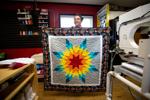
Native Life employee Brynnlee St. Goddard holds a store-made quilt with a series of Indigenous inspired designs. Few businesses around Browning that sell cultural crafts and goods are Native-owned.
About 10,600 people live on the Blackfeet Reservation, where the median household income is $34,731 and where 31% of residents live below the poverty level. In Montana, the median household income is $56,539, and about 12% of people live in poverty.
Attracting tourists to the reservation can be a sensitive subject. As part of a 20th-century promotional campaign for the Great Northern Railway, for example, Blackfeet tribal members were asked to wear headdresses and other regalia to greet tourists. Some Native vendors today feel uneasy when non-Native people buy their goods.
Other vendors make a point to educate customers on the cultural significance behind the items they purchase. Some local sellers are non-Native and sell mass-produced items — like plush tipis, blankets with buffalo or fabric with feather patterns — that look Native-made but aren’t. And all local vendors compete with giant corporations that capitalize on stereotypical Native designs, imagery and objects.
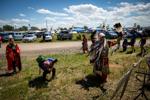
A tourist photographs a man in regalia at North American Indian Days in Browning on July 9. For many tourists who pass through Browning on their way to Glacier, it’s their first time interacting with Native communities.
It’s a tough landscape to navigate — both for sellers and tourists.
The Blackfeet Nation hopes to change that. The Blackfeet Tribal Business Council is professionalizing its tourism efforts, and the tribe envisions a future where tourists don’t just spend their money in the community but their time as well.
Tourism is a risky business
Relying on tourism is risky. In 2020, the tribe closed the east gate to Glacier National Park to prevent the spread of COVID-19 — a move that sacrificed vital tourism dollars. The tribe also canceled its North American Indian Days celebration in 2020, again due to COVID, and held a small-scale celebration in 2021.
This year, due to spring snowstorms, Glacier Park’s famous Going-to-the-Sun Road opened July 13 — the latest opening date since 2011. To the south, Yellowstone National Park faced unexpected closures due to catastrophic flooding in June. Both incidents prompted a slight decline in tourism on the Blackfeet Reservation.
Other unpredictable events, like wildfires, extreme weather incidents and soaring gas prices, can — and have — impacted the volume of tourism each season. In October 2013, for example, when the federal government shut down for 16 days, local businesses in Browning suffered.
Lisa Longtime Sleeping, manager of Native Life, said during that 2013 controversy, the tribe entered a months-long shutdown amid council turmoil. Because many reservation residents are employed by either the federal government or tribe, people had no income to spend at local businesses.
“People were selling their own belongings to pay for food and rent,” she said. “It got scary on the reservation. For Native Life, it set us back to the beginning.”
Longtime Sleeping said it can take years to come back from a loss like that, and Native Life still hasn’t recovered. Just as the store was gaining momentum, COVID-19 hit.
The store hasn’t made a profit since the 2013 shutdown. Longtime Sleeping and Angela Johnson, the store’s manager, try to travel to Los Angeles every year to buy fabric for their store. But Longtime Sleeping said they haven’t been able to afford the trip for years.
“We barely make ends meet,” Longtime Sleeping said, adding that Native Life “is a labor of love.”
For Native artists, ‘nowhere to go’
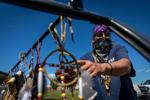
Mike Young Running Crane, a local Indigenous crafts seller, sells handicrafts out of his car at the North American Indian Days in Browning on July 9. Young Running Crane travels the reservation every day, selling items out of his car. The money he earns during the tribe’s North American Indian Days celebration are essential for him to make up much of the profit for the year.
Antonio Ibarra
Mike Young Running Crane makes medicine wheels, eye-glass holders, cellphone holders and other trinkets.
On the morning of the tribe’s Indian Days celebration, Young Running Crane, 58, parked his car near the parade route and decorated the hood, mirrors and roof with his work. When customers weren’t around, he sat inside his vehicle to escape the unrelenting heat.
Young Running Crane travels the reservation every day, selling items out of his car. Profits from Indian Days prove essential.
He’s not the only local artist who roams the reservation looking for buyers. St. Goddard said Native Life buys and sells paintings by Jeremy Johnson, a local artist, because Johnson can’t afford to buy a car and sells his work just to put food on the table.
“Native artists are undervalued,” she said. “They have to sell their work just to survive.”
Lola Wippert, who makes clothing and jewelry, said local artists used to walk the halls of Blackfeet Community College, the tribal college in Browning, to sell their work to students and professors.
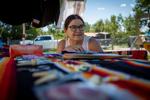
Lola Wippert, founder of Rezzy Creations, an Indigenous-owned store in downtown Browning, sells clothing and jewelry outside her home during North American Indian Days celebrations on July 9. Wippert founded Rezzy Creations so Native artists could have a place to sell their work.
Antonio Ibarra
“It seemed like they just had nowhere to go,” Wippert said of local Native artists.
Wippert used to sell items primarily out of her home. Like many local sellers, she relied heavily on word-of-mouth to attract customers.
She wanted to give local artists a space to sell their goods, so she founded Rezzy Creations, a store devoted to selling Blackfeet clothing and art.
In the new shop, located in downtown Browning, Wippert charges artists $50 a month to display their wares, and artists keep all profits of whatever sells.
Tough competition
As Native vendors on the reservation struggle to survive, they face tough competition. Large corporations sell mass-produced fabric with inauthentic Native imagery at low prices. For local Native sellers who don’t want to price their communities out, it’s nearly impossible to compete.
Though some ribbon skirts can sell for hundreds of dollars, Native Life and Wippert price theirs around $65 or $70.
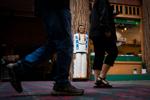
A sculpture of a wooden Indian is on display at the Glacier Park Lodge. Hotels and shops in East Glacier Park Village sell items of Native likenesses to tourists from all over.
“We price everything below market,” Wippert said. “Because we’re in a poor area, I want our people to afford it.”
Just down the road in East Glacier Park, non-Native-owned hotels showcase wooden statues of Native Americans, and shops sell items of Native likeness, like beaded jewelry or moccasins.
The competition edges even closer during Indian Days, when locals really need to capitalize on tourism profits.
Dozens of non-Native vendors nationwide travel the powwow circuit, selling their items in massive booths. The Blackfeet Nation aims to capitalize on these vendors by charging for each booth at Indian Days. McNeely said the tribe charges different rates for out-of-state, Blackfeet and local booths. But locals selling clothing, jewelry and art say the price is still too steep. It would outweigh what they’d make in a day.
“That’s why you don’t see local vendors there, except for people selling food,” St. Goddard said.
As a result, out-of-state vendors set up closest to the powwow and rodeo events, while Blackfeet sellers set up tents outside their homes, like Wippert, or in their car, like Young Running Crane, or hope that people wander into their shops, like St. Goddard.
Lailani Upham, who facilitates tourism marketing and economic development, said when people buy Native-looking jewelry on or near the reservation, they may incorrectly assume it’s Blackfeet-made. There are 574 federally recognized tribes in America, and each has its own unique history, language, stories and culture.
“When you see mass-produced items at powwow stands, it’s almost like putting us in a box,” Upham said. “The Blackfeet are so different from Navajo. People will buy jewelry made in China and think those earrings came from Blackfeet when it has nothing to do with our stories, history and heritage. It makes us look goofy. It’s wrong, it’s stereotypical, it’s not authentic and it’s fake.”

Many non-Native vendor booths flooded Indian Days celebrations in Browning. Most of the booths were part of an out-of-state group of vendors from Arizona looking to make money from selling Native goods to tourists.
Antonio Ibarra
Cultural sensitivities
St. Goddard said when tourists visit the Native Life shop, they almost never ask about cultural significance or sensitivities.
“It’s hard to tell if someone is non-Native these days because everyone walks in here claiming their grandma was Cherokee,” St. Goddard said, rolling her eyes. “Tourists never ask if something is appropriate — they just buy it.”
St. Goddard has mixed feelings about this. On the one hand, the store needs revenue to survive and continue serving its community. On the other hand, she wishes outsiders would put more effort into understanding the tribe and culture.
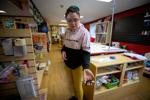
Brynnlee St. Goddard with Native Life holds a beaded cross on July 10 that she recently made for a priest visiting the Blackfeet Nation. Bead work is culturally significant for most Indigenous nations.
St. Goddard said she has noticed a change over the last few years. Some tourists have started to take an interest in Blackfeet ceremonies, and sometimes they’ll stop in the store to buy a ribbon skirt or ribbon shirt to wear to one.
Young Running Crane said he feels OK selling items to non-Natives “as long as they know what they’re buying.”
“I tell everyone the significance behind what they buy,” he said.
Wippert said she’s noticed that non-Natives seem more likely to buy jewelry than ribbon skirts or ribbon shirts.
“We rarely sell to white people, in general,” she said. “But I do encourage them to buy ribbon skirts to support us.”
‘Make this place a destination’
Upham launched and runs the tribe’s “Visit Blackfeet” Instagram and YouTube channel, where she hopes “to show people, tourists, and those inside and outside our community, what it means to visit Blackfeet country.”
She emphasizes community in her work.
“Community tourism means our whole community is being a host,” she said. “It’s showing people who we are, what we do, what is happening here. It’s about coming together to make this place a destination.”
Upham envisions local business owners taking over the Instagram account for a day. She wants to share a video of an outfitter on horseback, and she wants people to “go live,” sharing videos at events.
She said it’s critical that tourists get information about the Blackfeet from an authentic source.
“There’s been so much misunderstanding and stereotypes and mock crafts and art across the country and world, that it’s devaluing our stories, our history and our culture,” she said. “When our artists, our people, make artwork, it comes from our authenticity, which is our stories, our culture, our heritage, our ways of knowing and understanding the world around us.”
While there are several Native-owned restaurants and small businesses on the reservation, Upham said most can be hard to find. Not all businesses have a website or social media page, and some don’t have signs or storefronts to mark them.

While there are many Native-owned businesses on the Blackfeet Reservation, they can be hard for outsiders to find. Rezzy Creations is located near the Glacier Reporter building, but it’s behind a closed gate with no visible signage or storefront to attract customers.
Antonio Ibarra
Rezzy Creations, for example, is located in downtown Browning. The store is just one block from the Indian Days parade route, but for people not from the community, it might be hard to find. The shop is connected to the Glacier Reporter building, and it’s behind a closed gate with no visible storefront or signage signaling it’s a business.
‘Get people to stop here’
While the tribe hopes to attract tourists that will support local restaurants and businesses, the Blackfeet Nation is also after a bigger goal — to get tourists to spend meaningful time on the reservation.
On the other side of Glacier National Park, in West Glacier, there are mini-golf courses, historic mountain lodges, electric bicycle rental shops, horseback outfitters, boat tours, zip-lining and more. But on the Blackfeet Reservation along the east side of the park, there’s very little of that.

Native-inspired goods are on display and for sale at Browning’s Glacier Family Foods.
The tribe hopes to renovate and build new places to formalize, attract and sustain tourism, but it’s an uphill battle.
John Murray, the tribe’s historic preservation officer, said he’d heard rumors that old guide books advised tourists “not to stop in Browning,” citing false safety concerns.
At first, he didn’t believe it. But when he picked up a book at a Town Pump one day, Murray said, “it was there.”
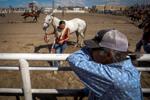
John Murray, Blackfeet tribal historic preservation officer, watches Indian horse relay races at Browning’s Stampede Park as powwow celebrations take place on the Blackfeet Nation.
Antonio Ibarra
“People come through here and they’re under an impression that they’re in danger,” he said. “We get a real bad image here. I think that’s probably what these people involved in tourism are trying to do — to get people to stop here.”
When the Blackfeet Tribal Business Council turned over the parks and recreation department to Blackfeet Manpower, director George Kipp knew he had a lot of work to do.
Blackfeet Manpower runs services and programs on the reservation, including rehab, child care, employment training, veterans’ services and parenting, among other things. The department has 70 full-time employees and manages the tribe’s campgrounds.
“Tourism is growing fast here,” Kipp said. “The tribe is realizing how important it is and what a big opportunity it is for revenue to come to this reservation. We want to grow the department as much as possible and make it more formalized.”
Kipp has short- and long-term visions for the program. His first priority is building a well-staffed tourism department. He and Upham are also finalizing an official website that will direct people to events, businesses and restaurants on the reservation.

Scenes from the Blackfeet Nation’s 2022 North American Indian Days in Browning on Saturday, July 9, 2022.
Kipp said a key issue is that many visitors don’t realize they are on the Blackfeet Reservation when they drive through it. To remedy this, he said Manpower plans to install better, more informative signage.
The tribe’s parks and recreation budget is about $60,000, and Kipp said Manpower will fill gaps in funding with tourism grants. He said the tribe also received funding from the state to create a buffalo interpretive center on a campground.
“The tribe’s vision is to use this as a central area for giving information to tourists and visitors about all recreation activities on the reservation,” he said, adding that the center will have information regarding camping, culture, restaurants and businesses. The campground is located across from the tribe’s bison herd, and Kipp predicts tourists will enjoy watching the animals.
Kipp said cultural leaders help inform Manpower’s tourism initiatives.
“Everything we do goes through them,” he said. “They make sure our sacred sites are well-kept. They let us know what is acceptable, what we can share with tourists and what we can’t. Things we do and don’t advertise.”
Manpower plans to renovate Charging Home Stampede Park in Browning, where rodeos are typically staged. Kipp said the tribe is contributing $1.8 million to the two-year restoration project.
“We want to rebuild the racetrack, enhance the concessions, bathroom, office space, entryway, parking lot and walking path around it,” he said.

Scenes from the Blackfeet Nation’s 2022 North American Indian Days in Browning on Saturday, July 9, 2022.
He said the tribe will continue to hold Indian relay races and rodeos in the park, but he envisions hosting other events there, like concerts or a circus.
In 2015, Jeff Ament, Pearl Jam’s bassist from Havre, donated the Thunder Park skate park to the Blackfeet Nation. Kipp said Manpower hopes to build a big walking path around the park, to promote tribal health. He also envisions playgrounds, picnic areas and comfortable spots for families and elders to convene.
“We also don’t plan to charge people who go there,” he said. “We just want to make it fun.”
Kipp also plans to attract tourists to Stampede Park in the winter — a particularly difficult task when Browning receives an average of 81 inches of snow each year. High winds and temperatures well below freezing make it hard to travel or be outside.
But Kipp is optimistic. He organized winter activities at the tribe’s Red Eagle campground last year and was surprised to see it was a big hit. Now he hopes to offer sledding, cross country skiing, snowshoeing, snowman building competitions and other activities to attract tourists in the off-season.
“We have mountains, we have lakes, we have campgrounds, there’s a lot of opportunity here,” Kipp said. “These plans, they’re going to happen. It’s just a long effort.”
